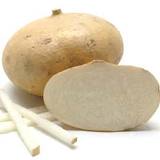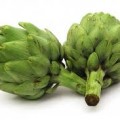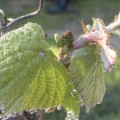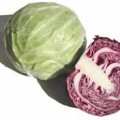Taxonomy & History
- Family: Fabaceae (Leguminosae)
- Pachyrhizus erosus
- Relative to the Sweet Potato
- AKA chop suey potato (Hawaii), yam bean, Mexican Turnip (Mexico)
- Although it originated in North America, it is most popular in China
Physical Description
- Plant:
- very attractive vine, which can twine up to 14 feet high or more.
- Leaves:
- Deep green foliage
- leaves have three leaflets
- poisonous
- Flowers:
- upright spikes of sweet pea-shaped purple or violet flowers in summer
- Fruit:
- Bean pods develop
- Ripe pods are poisonous
- Root:
- The edible part is its enlarged taproot, which develops underground like a beet and tastes a little like a sweet water chestnut.
- ugly, brown swollen taproot
- heart-shaped
Growth Habits
- climbing annual vine
- grows as a vine; can also be grown as a trailing mound on the ground
Varieties & Cultivars
Categories or Types
Colors Available
Varieties
Growth Requirements
Climate & Temperature Requirements
- If growing jicama for its edible root, it is best grown in Hawaii, zones H1 & H2
- Mainly ornamental in zones:
- 8
- 9
- 12
- 13
- 14
- 18-24
- In Southern California it will produce some poor-quality roots
- In Northern California, you will get only foliage & flowers
Seasonality
- Plant in late spring, after last frost
- roots enlarge in fall as days begin to grow shorter, but it still needs warmth to produce a good crop
- Maturity: 150 days
Air Temperature
- Needs a long, hot growing season, maturing at 150 days from transplant
- needs a lot of heat
Soil Temperature
Humidity
Day Length or Light Requirements
Site Conditions Favored
- full sun
Soil Requirements
Soil Texture
pH
Nutrient Requirements
- jicama needs rich soil
- very high nitrogen needs
Propagation
Methods of propagation
Seed
- Preferred method of propagation is by seed:
- Indoors:
- sow seeds 8-10 weeks before last frost
- plant outside after last frost, when the soil has warmed to 50 degrees F
- Outdoors:
- sow seeds in late spring, after last frost
- seeds should be sown 1/2″-3/4″ deep (although one source said to plant them 2″ deep) and 1″ apart
- thin to final spacing (see Planting Out)
- Indoors:
Transplanting or Potting Up
Seed Saving
Planting Out
- plant out after all danger of frost has passed, and the soil has warmed up
Bed Prep & Soil Amendments
Bed Spacing
- each vine needs ample room and full sun
- space plants 6″-8″ apart
Row Spacing
- rows should be 14″-24″ apart
Planting Depth
Alternative Bed Methods
Container Gardening
Routine Cultivation & Maintenance
Water Requirements
Fertilization Recommendations
- apply high-nitrogen fertilizer monthly
Mulching & Weeding
Pinching or Pruning & Dividing
- flowers should be pinched off for maximum root production
Support
- Support with trellis or allow it to trail from a mound
Winterizing
Companion Planting
Helpful Companions
Harmful Companions
Companion to..
Pests, Diseases & Problems
Common Pests
Common Diseases
Symptoms
Whole Plant
Leaves
Stem/Trunk
Flowers
Fruit
Roots
Harvesting & Storage
Edible Parts of the Plant
- edible root is crunchy and mild
- the tap root is a heart-shaped tuber with white flesh and brown skin
- leaves and ripe pods are poisonous
Yield
- each vine yields one edible root from 1 to 6 pounds
- the tap root will get to about 6 inches square
Days to Harvest / Harvest Timing
- plant reaches maturity at about 150 days, so the tubers will be forming after that
- the tuber develops after the vine is done flowering
- roots enlarge in fall as days begin to grow shorter, but it still needs warmth to produce a good crop
- harvest before first frost, or if there’s no frost in your area, you can leave them in the ground until needed
Harvest Methods
- dig up the root
Storage of harvest
Fresh
- stores very well fresh
- if there’s no frost in your area, you can leave the root in the ground
- similar to potatoes; keep cool and don’t peel before storage
- store dry, between 53 and 60 degrees F; do not refrigerate; will keep 30-60 days this way
Canned
Frozen
Pickled
Dried
Cooking & Nutrition or Toxicity
Nutritional Benefits & Values
- crunchy and mild, Jicama is a good substitute for water chestnuts or bamboo shoots in salads or stir-fries
- makes a crisp and delicious low-calorie snack
- texture is like raw potatoes; flavor is sweet and starchy
- high in carbohydrates, dietary fiber.
- 86-90% water
- contains only trace amounts of protein and fat
Toxicity
- ripe pods, leaves and vine are all poisonous
- seeds are poisonous due to the toxin rotenone, which is used in pesticides
Cooking
- Preparation
- peel off the rough brown skin and eat the white flesh raw or cooked
- Cooking Methods
- usually eaten fresh
- eat fresh on salads or vegetable plates
- marinate and stir-fry
- add to soups
- fresh seasonings: salt, lemon or lime juice, chili powder
- recipes with jicama often include cilantro, chiles, ginger, citrus, soy sauce, sesame
Recipes
(link to …/category/recipes/tag/[plantname])
Sources
Information for this article was taken from these sources:
- Kitazawa Seed Co
- Sunset Western Garden Book
- Wikipedia
Jicama: How to Grow, Harvest & Eat
This post is a placeholder for jicama growing, harvesting, and eating information.





